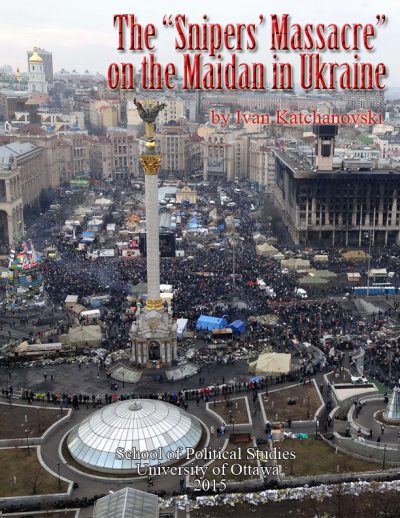The “Snipers’ Massacre” on the Maidan in Ukraine

In December 2015, Oriental Review published the research paper of Prof. Ivan Katchanovski from Ottawa University at the Annual Meeting of American Political Science Association in San Francisco, September 3-6, 2015.
Professor Katchanovski’s analysis is now fully confirmed following the release of Italy’s Canale 5 documentary, which includes interviews with three of the EuroMaidan snipers of Georgian nationality, conducted by renowned Italian journalist Gian Micalessin.
A summary of Prof. Katchanovski’s analysis is presented below. The full text of the research paper is available for downloading here (PDF – 2,5 Mb).
Unanswered Question. Why are Katchanovski writings and Micalessin’s Canale 5 Interviews which reveal the “unspoken truth” regarding the February 2014 Kiev Euromaidan coup d’Etat not the object of mainstream news coverage?
Media Omission constitutes a tacit instrument of war propaganda. Our Thanks to Oriental Review for bringing this important issue to the attention of the Independent media.
Michel Chossudovsky, Global Research, November 25, 2017
***
The massacre of almost 50 Maidan protesters on February 20, 2014 was a turning point in Ukrainian politics and a tipping point in the conflict between the West and Russia over Ukraine. This mass killing of the protesters and the mass shooting of the police that preceded it led to the overthrow of the government of Viktor Yanukovych and gave a start to a civil war in Donbas in Eastern Ukraine, Russian military intervention in Crimea and an international conflict between the West and Russia over Ukraine. A conclusion promoted by the post-Yanukovych governments and the media in Ukraine that the massacre was perpetrated by government snipers and special police units on a Yanukovych order has been nearly universally accepted by the Western governments, the media, and many scholars. The Ukrainian government investigation identified members of the special company of Berkut as responsible for killings of the absolute majority of the protesters, but did not release any evidence in support, with the exception of videos of the massacre.
The question is which side organized the “snipers’ massacre.” This paper is the first academic study of this crucial case of the mass killing. It uses a theory of rational choice and a Weberian theory of instrumental rationality to examine actions of major actors both from the Yanukovych government, specifically various police and security forces, and the Maidan opposition, specifically its far right and oligarchic elements, during the massacre.
The paper analyzes a large amount of evidence from different publicly available sources concerning this massacre and killings of specifics protestors. Qualitative content analysis includes the following data: about 1,500 videos and recordings of live internet and TV broadcasts in mass media and social media in different countries (some 150 gigabytes), news reports and social media posts by more than 100 journalists covering the massacre from Kyiv, some 5,000 photos, and nearly 30 gigabytes of publicly available radio intercepts of snipers and commanders from the special Alfa unit of the Security Service of Ukraine and Internal Troops, and Maidan massacre trial recordings. This study also employs field research on site of the massacre, eyewitness reports by both Maidan protesters and government special units commanders, statements by both former and current government officials, estimates of approximate ballistic trajectories, bullets and weapons used, and types of wounds among both protesters and the police. This study establishes a precise timeline for various events of the massacre, the locations of both the shooters and the government snipers, and the specific timeline and locations of nearly 50 protesters’ deaths. It also briefly analyzes other major cases of violence during and after the “Euromaidan.”
This academic investigation concludes that the massacre was a false flag operation, which was rationally planned and carried out with a goal of the overthrow of the government and seizure of power. It found various evidence of the involvement of an alliance of the far right organizations, specifically the Right Sector and Svoboda, and oligarchic parties, such as Fatherland. Concealed shooters and spotters were located in at least 20 Maidan-controlled buildings or areas. The various evidence that the protesters were killed from these locations include some 70 testimonies, primarily by Maidan protesters, several videos of “snipers” targeting protesters from these buildings, comparisons of positions of the specific protesters at the time of their killing and their entry wounds, and bullet impact signs. The study uncovered various videos and photos of armed Maidan “snipers” and spotters in many of these buildings.

